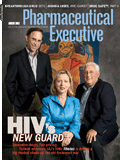Exclusivity vs. Patents
Pharmaceutical Executive
Twelve years is probably "the best deal the industry is going to get," comments former FDA official Scott Gottlieb. "This is a genuine compromise."
The delicate compromise on biosimilars crafted by leading Senate Democrats and Republicans in June tackles patent and exclusivity issues head-on. To encourage innovation while supporting access to less costly therapies, Congress proposes an extensive data-exclusivity period that would delay Food and Drug Administration (FDA) approval of a follow-on biologic (FOB) application for 12 years. This approach recognizes that patents may not provide comparable protection for large-molecule therapies.

Jill Wechsler
Biotech products regulated under the Public Health Service (PHS) Act have not benefited from data-exclusivity provisions provided for drugs. At the same time, the long R&D process for developing large-molecule therapies often eats up patent terms before a product gets to market.
Several added factors erode patent protection for biopharmaceuticals. Because biologics are made from living organisms, it is difficult to define the scope of the invention, which results in narrow patent claims. And biotech patents often cover cell lines, fermentation, and purification processes, which traditionally have not provided strong protection from competitors.
Biotech patents would provide less protection against follow-ons, moreover, because FOBs are not identical. The whole premise of the follow-on pathway is that the new products are similar to the innovator, but slightly different due to the nature of the production process and variations in active ingredients. Thus, follow-on makers could engineer production systems to develop new versions of a therapy without infringing process patents.
So if a new law permits FDA to approve abbreviated applications for FOBs, it would open the door to patent challenges on most newly approved biological products. Without substantial data exclusivity, we would see "an explosion in patent challenges shortly after a new product is launched," said Duke University economist Henry Grabowski at a seminar on FOBs sponsored by the American Enterprise Institute (AEI) in June. That could result in high litigation costs and added uncertainty for innovators about their ability to recover R&D expenses.
How Much Exclusivity?
The Biotechnology Industry Organization (BIO) asserts that 14 years of exclusivity protection is needed to maintain incentives for innovator firms to take on the costly biotech R&D process. Grabowski explained that it costs more than $1 billion to develop a new biotech therapy, including the cost of capital and of R&D failures; actual out-of-pocket cost runs over $500 million. This means that the "break-even lifetime" for a biologic—i.e., the time needed to recover R&D costs and earn a risk-adjusted return on capital—runs 13 to 16 years. Without such protection, small firms would have difficulty attracting venture capital firms and other investors.

More Biosimilars for Europe
Although one legislative proposal in the House offered 14 years of exclusivity, the FOB measure sponsored by Rep. Henry Waxman (D-CA) ignored the issue. This prompted policymakers to suggest splitting the difference with a seven-year exclusivity period. That would be similar to the exclusivity provided orphan drugs, a policy that has encouraged development of treatments for rare diseases.
Alternatively, the Hatch-Waxman Act of 1984 sets a floor with a five-year exclusivity period for conventional new drugs. That aimed to provide some protection from generic competition for those drugs that had little or no remaining patent protection at time of launch, but pharma companies consider it much too low for today's highly competitive market. The result has been extensive patent litigation with brand-name firms bringing infringement suits to keep generics off the market for another two or three years and filing new patents to extend exclusivity even longer.
At the other end of the spectrum is the 10+1 years' exclusivity for drugs and biologics in the European Union. A longer exclusivity period in Europe is warranted, conceded Bruce Downey, chairman of Barr Laboratories, at the AEI seminar, because price controls make it harder for manufacturers to recoup R&D investment. And patents expire earlier in Europe, he noted, because they don't become involved in lengthy litigation.
No Evergreening
Generics makers, not surprisingly, blasted the 12 years' exclusivity offered in the Senate compromise as "unprecedented and unwarranted." Kathleen Jaeger, president of the Generic Pharmaceutical Association (GPhA), sought clearer limits on products eligible for exclusivity and language to prevent "evergreening" patent monopolies through minor product changes.
In finalizing the bill, Sen. Edward Kennedy (D-MA), chairman of the Senate Health, Education, Labor and Pensions (HELP) Committee, clarified that a reference product can have only one 12-year exclusivity period. Such exclusivity starts the day FDA approves the new therapy for market, and innovators can't add more years by developing new formulations or dosage forms, adding new indications, or conducting pediatric studies. The exclusivity applies only to a biotech product that is comparable to a "new chemical entity" for drugs, not to a slightly different version of an existing treatment.
Kennedy touted this compromise as a way to preserve incentives for bringing lifesaving medicines to patients. "Congress has a responsibility to encourage the innovation that leads to these new medical miracles," he said. Sens. Orrin Hatch (R-UT), Mike Enzi (R-WY), ranking Republican on the HELP committee, and Hillary Clinton (D-NY) all signed off on the measure, making subsequent partisan changes difficult.
One reason for agreeing to 12 years' exclusivity, said Clinton, is that many biotech therapies have been on the market long enough to be eligible immediately for follow-on competition. Amgen's anemia treatment Epogen (epoetin alfa), for example, was approved in the United States in 1989, and other biologics have or will soon exceed the exclusivity period.
Twelve years is probably "the best deal the industry is going to get," comments former FDA official Scott Gottlieb. "This is a genuine compromise."
Interchangeability Possible
Despite protests from generics makers, much of the Senate package meets their demands. The legislation provides a pathway for developing interchangeable FOBs that can be substituted for an innovator product. And follow-on sponsors would get a one-year data-exclusivity award as an incentive to take that route. To gain approval of an FOB that pharmacists can substitute for the original product without the prescriber's OK, the follow-on maker will have to conduct clinical trials to demonstrate that the new product can be used without any noticeable differences, a requirement that addresses legitimate safety concerns.
The Senate plan also permits generics makers to file an application for a biosimilar four years after the start of the innovator's exclusivity period as one way to resolve some patent issues early on. When FDA accepts the FOB application, that triggers a multi-step process for exchanging confidential information between the follow-on firm and the innovator on manufacturing process and product characteristics and patents likely to be affected. Innovators are concerned that the follow-on firm eventually will determine which patents can be litigated, making it harder to defend patent rights.
Biotech companies still can enforce patents awarded after the filing of a follow-on application, but that involves additional procedures for dealing with later patent litigation. Whether all these provisions will reduce litigation in an equitable manner remains to be seen.
Flexibility for FDA
The main testing and regulatory provisions of the FOB legislation reflect further trade-offs for innovators and generics firms. The agreement calls for at least one or more clinical studies to assess the immunogenicity of a follow-on, but it gives FDA leeway to waive that requirement.
FDA may develop guidance for testing and developing FOBs, but generics firms don't have to wait for published guidance to move forward with testing and applications. Such guidance could indicate that existing science does not support follow-ons for a certain product class, but FDA could revise such a finding later on.
Follow-on applicants initially will pay user fees on applications, while FDA assesses the cost of running the program as the basis for adjusting the fee structure later. Also, the FDA review division that approved the innovator will assess any follow-ons—not FDA's Office of Generic Drugs. This could encourage FDA reviewers to compare proprietary brand data when evaluating an FOB, something that innovators strongly oppose.
An interesting provision in the Senate bill calls for the government to determine how much money the healthcare system saves by allowing FOBs to come to market. The Department of the Treasury will study the market and establish a Biological Product Savings Fund to channel those savings to other public health programs. A lot of interest groups have predicted huge gains from FOBs, and it will be interesting to see the results.
Jill Wechsler is Pharmaceutical Executive's Washington correspondent. She can be reached at jwechsler@advanstar.com
FDA Grants Priority Review to Regeneron’s Eylea for Macular Edema Following Retinal Vein Occlusion
April 18th 2025Regulatory action was based on data from the Phase III QUASAR trial, which demonstrated that Eylea HD dosed every eight weeks achieved non-inferior visual acuity outcomes compared to Eylea in patients with macular edema following retinal vein occlusion.
Navigating Distrust: Pharma in the Age of Social Media
February 18th 2025Ian Baer, Founder and CEO of Sooth, discusses how the growing distrust in social media will impact industry marketing strategies and the relationships between pharmaceutical companies and the patients they aim to serve. He also explains dark social, how to combat misinformation, closing the trust gap, and more.
